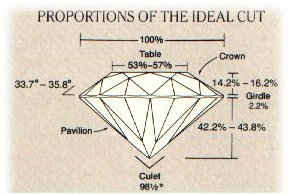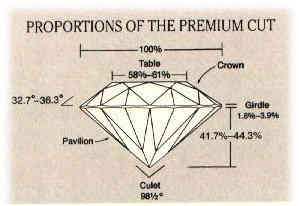
When you acquire diamond jewelry, you'll want your diamonds, no matter what their size, to be the best your money can buy. Any difference in quality means a difference in price.
Cut
Many people confuse cut with the shape of a diamond. The shape you select is a matter of individual taste, and today your choice is only limited by the skill and imagination of the craftsman. It is their effort during every stage of the fashioning process that reflects the maximum amount of light back to the eye. Most round, brilliant-cut or fancy-shaped diamonds possess 58 carefully angled flat surfaces, called facets, whose placement will affect the fire, brilliance and ultimate beauty of your diamond.

The Ideal Cut
When a round brilliant diamond has been cut to "Ideal" proportions by a master cutter, it is a splendor to behold.
The Ideal Cut Diamond describes a round brilliant diamond that has been cut to exact and mathematically proven proportions.
It's symmerty, with 58 exactly placed facets, produces the ultimate in lustre and beauty.
When a diamond is cut to the ideal proportions, all of the light entering from any direction is totally reflected through the top
and is dispersed into a display of sparkling flashes and rainbow colors.

Premium Cut
A Premium Cut Diamond demonstrates slight variations from the Ideal Cut. Although dimensional differences affect a
diamond's reflection of light balance between its porportions and the display of brilliance.
To be avoided are the "Class 3", "Spread" and poorly cut diamonds.
These have been so haphazardly cut to preserve as much weight as possible from the original rough crystal that the light never
has a chance to reflect, disperse and return to the eye of the viewer.
These inferior cut diamonds are always much less expensive than a proper cut diamond.. at the expense of the beauty. It is
possible to have, as an example, two one carat certified diamonds of say G VS1 that are over 30% different in price. While
one is a perfect Ideal Cut and displays maximum beauty, the less expensive is poorly cut and without life and brilliance we
expect in a diamond.
It is important not to consider "Certified" grades of color and clarity alone, cut must also be considered in the selection and value of a diamond.
Color
The most prized diamonds are colorless diamonds, because their beauty depends entirely upon their remarkable optical properties. In such diamonds, all the colors of the rainbow are reflected back to your eye. While the majority of gem diamonds appear to be colorless, others can contain increasing shades of yellow to brown, some of which are referred to as champagne diamonds. Other diamonds of exceptional color--red, blue, green, pink, and amber--are known as "Fancies."
The color grading scale varies from totally colorless to light color or tinted. The difference between one grade and its neighbor is very subtle. Experts never try to remember color; they use master diamonds of known color for comparison.

D | E | F | G | H | I | J | K | L | M | N | O | P | Q | R | S | T | U | V | W | X | Y | Z |
|---|---|---|---|---|---|---|---|---|---|---|---|---|---|---|---|---|---|---|---|---|---|---|
Colorless | Near Colorless | Faint Yellow | Very Light Yellow | Light Yellow | ||||||||||||||||||
Clarity
Because of their unique optical properties, diamonds, more than any other gemstone, are capable of producing the maximum amount of brilliance. While minute crystals of diamond or other minerals are contained in almost all diamonds, a diamond that is virtually free of inclusions and surface markings will be judged as flawless. In these diamonds, nothing interferes with the passage of light or spoils the beauty. But these diamonds are extremely rare and will command a high price.
To determine a diamond's clarity grading, it must be examined under a 10x magnification by a trained, skilled eye. What minute inclusions there may be make every diamond unique. These are, in fact, nature's fingerprints and do not mar the diamond's beauty nor endanger its durability. Without high magnification, you may never see these inclusions. However, the fewer there are, the rarer your diamond will be.
Flawess | Internally Flawess | VVS1 | VVS2 | VS1 | VS2 | SI1 | SI2 | I1 | I2 | I3 |
|---|---|---|---|---|---|---|---|---|---|---|
No Inclusions at 10X | Minute, extremely diffucult to see inclusions at 10X | Minor, diffucult to find inclusions at 10X | Noticeable, somewhat easy to find inclusions at 10X | Obvious under 10X, visible to the naked eye inclusions | ||||||
Carat-Weight
As with all precious stones, the weight--and therefore the size--of a diamond is expressed in carats. One carat is divided into
100 "points" so that a diamond of 25 points is described as a quarter of a carat or 0.25 carats. Size is the most obvious factor
in determining the value of a diamond, but now you know that two equal sizes can have very unequal prices depending on their
quality. However, remember that diamonds of high quality can be found in all size ranges.
Note:= One CTW = 200 mg;
Confidence in your Jeweler
When you are ready to choose your diamond, see a reliable jeweler. Jewelers are the experts who will be happy to explain the 4C's to you in more detail. They will also be able to show you beautiful diamonds in many sizes and can tell you the difference between various qualities of diamonds and how these differences affect the price you pay. Established jewelers prize their good reputation, and know you are making one of your most important purchases. They can help you select the very best your money can buy.